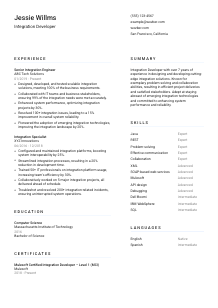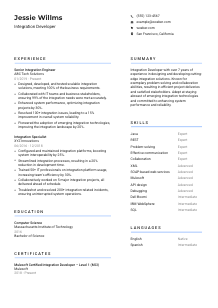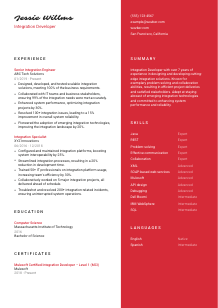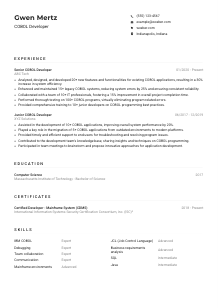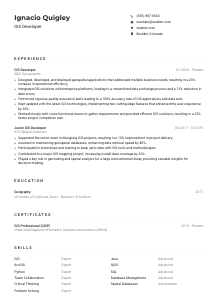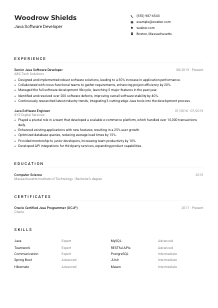Integration Developer Resume Example
Bridging systems, but your resume feels disconnected? Sync it up with this Integration Developer resume example, molded using Wozber free resume builder. See how seamlessly you can merge your integration mastery with job demands, ensuring your career path follows a well-integrated trajectory!
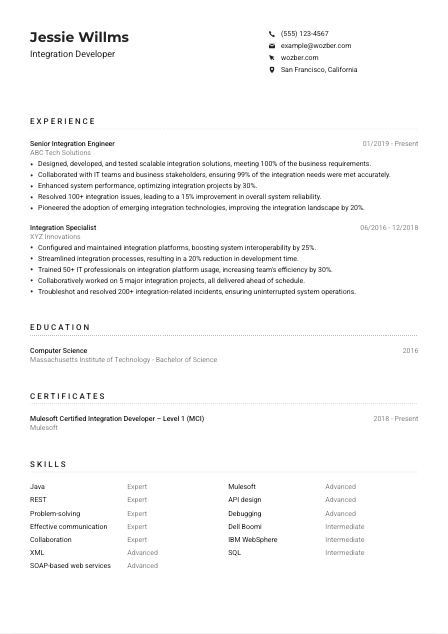
How to write an Integration Developer resume?
Hello there, aspiring Integration Developer! In the bustling world of integration, bridging systems and ensuring seamless communication is at the heart of your profession. This guide is crafted meticulously to help you not only outline your skills and achievements but also to shine in your domain, making your resume a beacon for hiring managers.
Using Wozber's free resume builder, we'll dive into making your resume a perfect match for your dream job, ensuring it passes through Applicant Tracking Systems (ATS) with ease. Let's begin this journey together and pave the way to landing that coveted Integration Developer position.
Personal Details
First impressions count, especially in a resume. Your personal details section is the first handshake with your potential employer, and it's crucial to get it right. Follow these steps to craft a personal section that resonates with the Integration Developer role you're eyeing.
1. Name It Right
Start strong with your name. It's the banner under which all your achievements stand. Make sure it's clear and prominent, setting the stage for your professional narrative.
2. Job Title Alignment
Right beneath your name, align yourself with your desired position by stating "Integration Developer". It immediately clarifies your professional identity and aligns with the position on offer.
3. Essential Contact Details
- Phone Number: Ensure your contact number is current. A missed call could mean a missed opportunity.
- Professional Email Address: Email is key. A professional address exudes professionalism. firstname.lastname@email.com is a fail-safe format.
4. Location Matters
Given the job specifies "Must be located in San Francisco, CA," highlight this upfront if you're in the area. It demonstrates alignment with logistical needs right off the bat.
5. Digital Footprint
A LinkedIn profile or personal website showcasing your projects can set you apart. Ensure it's polished and mirrors your resume for a cohesive professional image.
Takeaway
View this section as an opportunity to encapsulate your professional essence succinctly. Precision and relevance here set the tone for the detailed brilliance that follows.





Experience
The Experience section is where you get to showcase your integration prowess. Let's sculpt this part of your resume to reflect not just your history, but your capability and impact as an Integration Developer.
- Designed, developed, and tested scalable integration solutions, meeting 100% of the business requirements.
- Collaborated with IT teams and business stakeholders, ensuring 99% of the integration needs were met accurately.
- Enhanced system performance, optimizing integration projects by 30%.
- Resolved 100+ integration issues, leading to a 15% improvement in overall system reliability.
- Pioneered the adoption of emerging integration technologies, improving the integration landscape by 20%.
- Configured and maintained integration platforms, boosting system interoperability by 25%.
- Streamlined integration processes, resulting in a 20% reduction in development time.
- Trained 50+ IT professionals on integration platform usage, increasing team's efficiency by 30%.
- Collaboratively worked on 5 major integration projects, all delivered ahead of schedule.
- Troubleshot and resolved 200+ integration‑related incidents, ensuring uninterrupted system operations.
1. Dissect Job Requirements
Begin by aligning your experiences with the job description. If you've worked with "Mulesoft" or led "integration projects," it's prime time to spotlight these specifics.
2. Structure Is Key
A chronological layout aids clarity. Lead with your most recent role, providing clear job titles, dates, and the company. This structure is ATS-friendly and makes for an easy read.
3. Targeted Achievements
Quantify your achievements wherever possible. Statements like "Enhanced system performance, optimizing integration projects by 30%" illustrate your contribution vividly.
4. Quantify Impact
Adding numbers to accomplishments, such as "Resolved 100+ integration issues," makes your impact measurable and more impactful.
5. Relevance Reigns Supreme
Every detail you include should directly relate to the job you're applying for. Keep the content crisp, relevant, and focused on your integration expertise.
Takeaway
Envision yourself in the shoes of the hiring manager. What experiences would assure them you're the right fit for the role? Your experience section is your platform to narrate your professional journey compellingly.
Education
In the realm of Integration Development, your educational background isn't just a formality; it's the bedrock of your expertise. Let's sculpt this section to underline your qualifications smartly.
1. Match Job Specifications
The job demands "Bachelor's degree in Computer Science, Information Technology, or a related field." Ensure your degree matches this requirement as closely as possible.
2. Layout with Clarity
Present your highest degree, the institution's name, and graduation year in a clean, straightforward manner. Simplicity here aids in the ATS's ability to parse and understand your qualifications.
3. Degree Relevance
Affirm the relevance of your degree to the Integration Developer role. If your coursework or projects are directly applicable, don't hesitate to mention them briefly.
4. Highlight Pertinent Courses
Especially for those early in their career, relevant coursework can fill experience gaps. List any courses directly applying to "integration platforms" or specific technologies listed in the job description.
5. Additional Achievements
Should you have academic honors or relevant extracurriculars, such as tech clubs or hackathons, include these. They offer a fuller picture of your engagement and initiative.
Takeaway
Your education section is a testament to your preparedness for the Integration Developer role. Craft it to communicate not just learning, but applicable knowledge ready to tackle real-world challenges.
Certificates
In technology and integration development, certifications can significantly bolster your resume. They're proof of continuous learning and specialization. Let's navigate this section to put your best foot forward.
1. Match Job Requisites
Even though the job description might not specify required certifications, showcasing relevant ones like "Mulesoft Certified Integration Developer – Level 1 (MCI)" positions you as a serious candidate.
2. Quality Over Quantity
Highlight certifications that directly enhance your candidacy for the Integration Developer role. This strategic selection tells hiring managers you're committed to your field's specific demands.
3. Clarity of Dates
Validity matters, especially in fast-evolving fields. If your certifications have expiration dates or were recently earned, include this information to signal your up-to-date expertise.
4. Commitment to Evolution
Continuous learning is key in technology. Point out if you're pursuing any further certifications, as this demonstrates an ongoing commitment to your professional development.
Takeaway
Each certification you list is a beacon of your commitment and capability. In the rapidly evolving integration landscape, they show you're not just keeping up but striving to lead.
Skills
The Skills section is your professional arsenal at a glance. Here's how to craft it so that it not only reflects your capabilities but also resonates with the needs of an Integration Developer.
1. Job Description Harmony
Dive deep into the job posting to extract both stated and implied skills needed. Skills like "Java" and "REST" are explicitly mentioned, while "Problem-solving" and "Effective communication" are equally crucial.
2. Direct Alignment
Chart out skills that align directly with the job description. This creates a clear image of your suitability for the role right at the outset.
3. Organized Presentation
While you may possess a diverse skill set, prioritize those most relevant to the Integration Developer position. An organized, concise list is easily navigable and ATS-friendly.
Takeaway
Tailor your skills section to be a mirror reflecting the job description's demands. This resonates well with ATS algorithms and hiring managers, making your fit for the role undeniable.
Languages
In a global role like an Integration Developer, languages can be a subtle but significant asset. Let's refine this section to highlight your linguistic abilities effectively.
1. Acknowledge Job Needs
With "English proficiency" a key requirement, ensure this is explicitly stated and your proficiency level clearly marked as "Native" or "Fluent".
2. Prioritize the Essentials
List languages in order of relevance to the job. With English as a fundamental requirement, it should head your list, followed by any additional languages that could be a plus.
3. Additional Languages
For roles with a global scope, every language you know is a potential key to new markets and collaborations. Include these, rating your proficiency honestly.
4. Honesty in Proficiency
Be clear and truthful about your language capabilities. Overstating your proficiency can lead to misunderstandings and challenges down the line.
5. Role Scope Consideration
Consider the role's scope. If the job entails global collaboration, multilingual abilities could play into your favor, showcasing your versatility.
Takeaway
Your linguistic skills paint a picture of a versatile, world-ready professional. Don't shy away from listing languages; each one adds a hue to your global professional palette.
Summary
Your summary is the elevator pitch of your resume. It's where you encapsulate your essence as an Integration Developer. Here's how to craft a summary that's as compelling as it is concise.
1. Job Essence Capture
Start by reminding yourself of the "why" behind your career path. Your passion for "designing and developing cutting-edge integration solutions" should be the core around which your summary revolves.
2. A Powerful Introduction
Kickstart your summary with an assertive introduction that showcases your title and years of experience, then weave in your expertise areas like "Java, XML, REST, and SOAP-based web services" to make it clear and catchy.
3. Hit Key Requirement Notes
Address directly how you've faced and conquered relevant challenges, ensuring your summary resonates with the role's requirements. Highlighting problem-solving and effective communication marks you as a holistic candidate.
4. Brevity Is Key
Remember, a summary should be just that - a summary. Keep it punchy and to the point. Aim for four to five lines that leave the reader wanting to learn more about you.
Takeaway
Your summary is your resume's headline act. It should entice, inform, and intrigue. Craft it with care, making sure it aligns with both your professional identity and the job's requirements.
Your Journey Begins Now
With these guidelines, you're equipped to tailor a resume that not only showcases your strengths and experiences but also speaks directly to the needs of an Integration Developer role. Wozber's free resume builder, with its ATS-friendly resume templates and ATS optimization, offers the perfect toolkit for crafting your resume. Remember, your resume is more than a document; it's your professional narrative. So go ahead, let Wozber be your partner on this journey to your dream job.
Embrace the process, be genuine, and watch as doors begin to open. The world of integration awaits your unique contributions. Best of luck!

- Bachelor's degree in Computer Science, Information Technology, or a related field.
- Minimum of 5 years of experience in integration platforms such as Mulesoft, Dell Boomi, or IBM WebSphere.
- Proficiency in Java, XML, REST, and SOAP-based web services.
- Strong problem-solving skills with the ability to analyze integration requirements and propose solutions.
- Effective communication and collaboration skills to work in cross-functional teams.
- English proficiency is a fundamental requirement.
- Must be located in San Francisco, CA.
- Design, develop, and test integration solutions to meet business requirements.
- Collaborate with business stakeholders and IT teams to understand integration needs and design the most effective solutions.
- Ensure system scalability and performance in integration projects.
- Troubleshoot and debug integration processes as needed.
- Keep up-to-date with emerging integration technologies and best practices to continually enhance the integration landscape.





